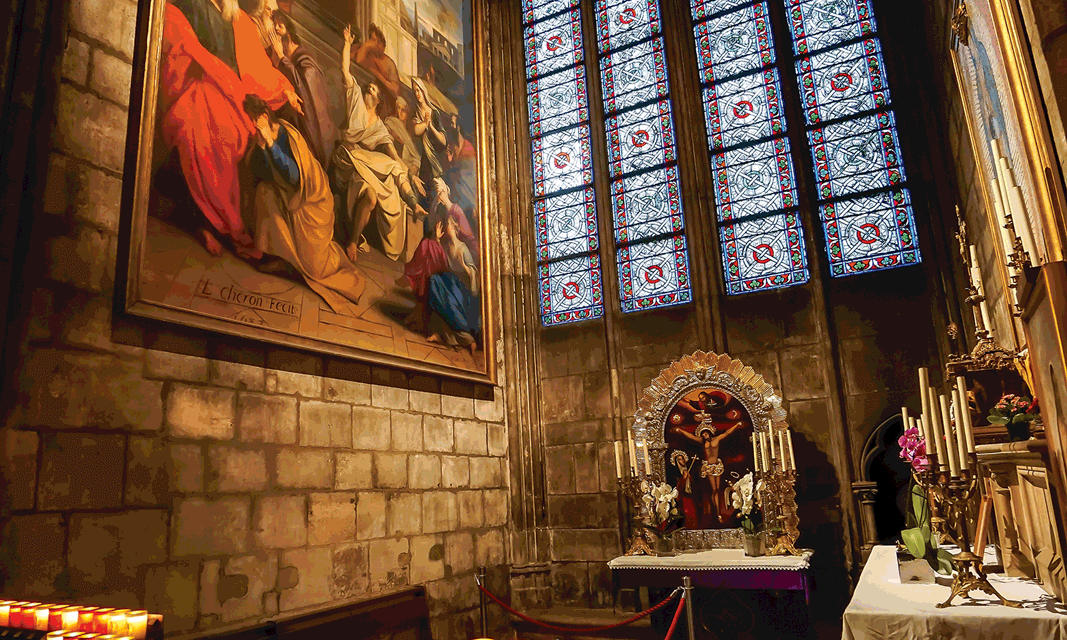Notre-Dame Cathedral, pictured in 2017. Many experts see the plan to replace undamaged stained-glass windows as a violation of cultural heritage guidelines
Photo: Zefart
A highly sensitive file is sitting on French President Emmanuel Macron’s desk. It does not concern the war in the Middle East or Ukraine, the Olympic Games, nor the political crisis caused by his recent election defeats. Instead, it deals with the stained-glass windows of six chapels on the lower south side of Notre-Dame cathedral.
In December 2023, the archbishop of Paris, Laurent Ulrich, and Macron, announced that the windows—commissioned by the architects Eugène Viollet-le-Duc and Jean-Baptiste Lassus when they restored the cathedral in the middle of the 19th century—would be replaced by contemporary creations. The windows had suffered no damage in the fire that destroyed Viollet-Le-Duc’s spire five years ago; they just needed a clean.
Experts, architects and art historians argue that the plans constitute a violation of the principles of the 1964 Venice Charter and other cultural heritage guidelines, which state that “items of sculpture, painting or decoration, which form an integral part of a monument, may only be removed if this is the sole means of ensuring their preservation”, and “the valid contributions of all periods to the building of a monument must be respected”.
Macron has been keen to add a personal touch to the restoration of the cathedral. In the days following the 2019 fire, the politician launched an international competition for the design of a new, modern spire, but the resulting controversy forced him to drop the idea. The National Heritage and Architecture Commission then unanimously approved the identical restoration of Viollet-Le-Duc’s spire and Macron said he “trusted its expertise”.
This summer, on the grounds of two technical and historical reports, the same consultative commission unanimously rejected the Macron plan to replace the chapels’ 19th-century windows with works by living artists. The magazine La Tribune de l’Art subsequently launched a petition, which drew more than 147,000 signatures urging the president to reconsider his decision. But Macron is holding his ground and is determined to push ahead.
The stained-glass window installed in the Saint-Eloi chapel in 1865 may be replaced
Photo © markobe
Meanwhile, the culture minister, Rachida Dati, has chosen to ignore the commission’s verdict and has called for a new session in September to “examine the different proposals for the modern replacements”. Around 110 teams of artists and glassmakers have submitted proposals for a new design. Out of the five finalists, the artist Pascal Convert chose to withdraw his contribution following the commission’s negative appraisal.
It is not the first time that the church has tried to replace some of the 19th-century windows, which are widely considered to be somewhat lacklustre in comparison with the more colourful Gothic or neo-Gothic examples in the cathedral. To let more light into the building, Viollet-le-Duc had to replace several windows that had been damaged or destroyed by the church in 1758. For these chapels, the architect deliberately chose windows in “grisaille”, featuring geometric forms on translucent glass. “He was seeking a harmony between the windows, the wall ornamentation and the furniture”, writes the heritage curator Elisabeth Pillet in a study published by the culture ministy.
In 1937, other windows in the cathedral were replaced by modern examples by a dozen artists, which are currently the focus of an exhibition at the Stained Glass Center in Troyes (until 5 January 2025). Painters including Pierre Bonnard, Raoul Dufy and Maurice Denis defended the idea at the time, but the press heavily criticised these “clown-like” creations, which looked like a “jazz orchestra led by a drunk musician”. The association for the safeguarding of French art launched a petition against such a “profanation”. The windows were removed in 1939 for protection against the coming war and were never put back in place. On 22 April 1939, Le Figaro newspaper wrote that it was surprised by the severity of the controversy, which showed that even amid an economic crisis and the threat of war, “Parisians are still capable of showing such a passion for an artistic matter”.

